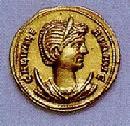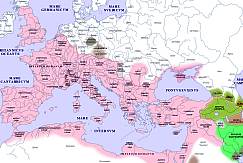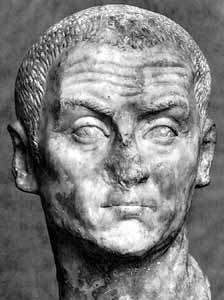Roman Emperors Dir Diocletian
Diocletian ( 284-305 A.D.)
Ralph W. Mathisen
Summary and Introduction
The Emperor Gaius Aurelius Valerius Diocletianus (A.D. 284-305) put an end to the disastrous phase of Roman history known as the "Military Anarchy" or the "Imperial Crisis" (235-284). He established an obvious military despotism and was responsible for laying the groundwork for the second phase of the Roman Empire, which is known variously as the "Dominate," the "Tetrarchy," the "Later Roman Empire," or the "Byzantine Empire." His reforms ensured the continuity of the Roman Empire in the east for more than a thousand years.
Diocletian's Early Life and Reign
Diocletian was born ca. 236/237 on the Dalmatian coast, perhaps at Salona. He was of very humble birth, and was originally named Diocles. He would have received little education beyond an elementary literacy and he was apparently deeply imbued with religious piety He had a wife Prisca and a daughter Valeria, both of whom reputedly were Christians. During Diocletian's early life, the Roman empire was in the midst of turmoil. In the early years of the third century, emperors increasingly insecure on their thrones had granted inflationary pay raises to the soldiers. The only meaningful income the soldiers now received was in the form of gold donatives granted by newly acclaimed emperors. Beginning in 235, armies throughout the empire began to set up their generals as rival emperors. The resultant civil wars opened up the empire to invasion in both the north, by the Franks, Alamanni, and Goths, and the east, by the Sassanid Persians. Another reason for the unrest in the army was the great gap between the social background of the common soldiers and the officer corps.
Diocletian sought his fortune in the army. He showed himself to be a shrewd, able, and ambitious individual. He is first attested as "Duke of Moesia" (an area on the banks of the lower Danube River), with responsibility for border defense. He was a prudent and methodical officer, a seeker of victory rather than glory. In 282, the legions of the upper Danube proclaimed the praetorian prefect Carus as emperor. Diocletian found favor under the new emperor, and was promoted to Count of the Domestics, the commander of the cavalry arm of the imperial bodyguard. In 283 he was granted the honor of a consulate.
In 284, in the midst of a campaign against the Persians, Carus was killed, struck by a bolt of lightning which one writer noted might have been forged in a legionary armory. This left the empire in the hands of his two young sons, Numerian in the east and Carinus in the west. Soon thereafter, Numerian died under mysterious circumstances near Nicomedia, and Diocletian was acclaimed emperor in his place. At this time he changed his name from Diocles to Diocletian. In 285 Carinus was killed in a battle near Belgrade, and Diocletian gained control of the entire empire.
Diocletian's Administrative and Military Reforms
As emperor, Diocletian was faced with many problems. His most immediate concerns were to bring the mutinous and increasingly barbarized Roman armies back under control and to make the frontiers once again secure from invasion. His long-term goals were to restore effective government and economic prosperity to the empire. Diocletian concluded that stern measures were necessary if these problems were to be solved. He felt that it was the responsibility of the imperial government to take whatever steps were necessary, no matter how harsh or innovative, to bring the empire back under control.
Diocletian was able to bring the army back under control by making several changes. He subdivided the roughly fifty existing provinces into approximately one hundred. The provinces also were apportioned among twelve "dioceses," each under a "vicar," and later also among four "prefectures," each under a "praetorian prefect." As a result, the imperial bureaucracy became increasingly bloated. He institutionalized the policy of separating civil and military careers. He divided the army itself into so-called "border troops," actually an ineffective citizen militia, and "palace troops," the real field army, which often was led by the emperor in person.
Following the precedent of Aurelian (A.D.270-275), Diocletian transformed the emperorship into an out-and-out oriental monarchy. Access to him became restricted; he now was addressed not as First Citizen (Princeps) or the soldierly general (Imperator), but as Lord and Master (Dominus Noster) . Those in audience were required to prostrate themselves on the ground before him.
Diocletian also concluded that the empire was too large and complex to be ruled by only a single emperor. Therefore, in order to provide an imperial presence throughout the empire, he introduced the "Tetrarchy," or "Rule by Four." In 285, he named his lieutenant Maximianus "Caesar," and assigned him the western half of the empire. This practice began the process which would culminate with the de facto split of the empire in 395. Both Diocletian and Maximianus adopted divine attributes. Diocletian was identified with Jupiter and Maximianus with Hercules. In 286, Diocletian promoted Maximianus to the rank of Augustus, "Senior Emperor," and in 293 he appointed two new Caesars, Constantius (the father of Constantine I ), who was given Gaul and Britain in the west, and Galerius, who was assigned the Balkans in the east.
By instituting his Tetrarchy, Diocletian also hoped to solve another problem. In the Augustan Principate, there had been no constitutional method for choosing new emperors. According to Diocletian's plan, the successor of each Augustus would be the respective Caesar, who then would name a new Caesar. Initially, the Tetrarchy operated smoothly and effectively.
Once the army was under control, Diocletian could turn his attention to other problems. The borders were restored and strengthened. In the early years of his reign, Diocletian and his subordinates were able to defeat foreign enemies such as Alamanni, Sarmatians, Saracens, Franks, and Persians, and to put down rebellions in Britain and Egypt. The easter frontier was actually expanded.
.
Diocletian's Economic Reforms
Another problem was the economy, which was in an especially sorry state. The coinage had become so debased as to be virtually worthless. Diocletian's attempt to reissue good gold and silver coins failed because there simply was not enough gold and silver available to restore confidence in the currency. A "Maximum Price Edict" issued in 301, intended to curb inflation, served only to drive goods onto the black market. Diocletian finally accepted the ruin of the money economy and revised the tax system so that it was based on payments in kind . The soldiers too came to be paid in kind.
In order to assure the long term survival of the empire, Diocletian identified certain occupations which he felt would have to be performed. These were known as the "compulsory services." They included such occupations as soldiers, bakers, members of town councils, and tenant farmers. These functions became hereditary, and those engaging in them were inhibited from changing their careers. The repetitious nature of these laws, however, suggests that they were not widely obeyed. Diocletian also expanded the policy of third-century emperors of restricting the entry of senators into high-ranking governmental posts, especially military ones.
Diocletian attempted to use the state religion as a unifying element. Encouraged by the Caesar Galerius, Diocletian in 303 issued a series of four increasingly harsh decrees designed to compel Christians to take part in the imperial cult, the traditional means by which allegiance was pledged to the empire. This began the so-called "Great Persecution."
Diocletian's Resignation and Death
On 1 May 305, wearied by his twenty years in office, and determined to implement his method for the imperial succession, Diocletian abdicated. He compelled his co-regent Maximianus to do the same. Constantius and Galerius then became the new Augusti, and two new Caesars were selected, Maximinus (305-313) in the east and Severus (305- 307) in the west. Diocletian then retired to his palace at Split on the Croatian coast. In 308 he declined an offer to resume the purple, and the aged ex-emperor died at Split on 3 December 316.
Prisca, Galeria Valeria, and Candidianus
Michael DiMaio, Jr.
 Galeria Valeria
Galeria Valeria
Prisca was the wife of the Emperor Diocletian. She bore him a daughter named Valeria, who was apparently the second wife of the Emperor Galerius. Although she was a Christian or favorably disposed to Christianity, she was forced to sacrifice to the gods during the Great Persecution of 303. Her husband had built her a home in Nicomedeia. When Galerius died in 311, she and her daughter were exiled to Syria by the Emperor Maximinus Daia . She was later arrested and beheaded by the Emperor Licinius in 315.
Valeria, like her mother a Christian or Christian sympathizer, seems to have married Galerius in 293 and, perhaps in November 308, was raised to the rank of Augusta and Mater Castrorum. Her husband named a province after her. She adopted Candidianus, Galerius's illegitimate son, as her own child; he was betrothed to the daughter of Maximinus Daia . Valeria and her mother Prisca fled from Licinius , to whose care they had been entrusted, to the realm of Daia after Galerius died in 311. When Valeria did not accede to Daia's wishes to marry him, the emperor took possession of all her property and exiled Valeria and her mother to Syria. When he died, Licinius sentenced her to death. Valeria escaped from his clutches and survived in hiding for over a year. Licinius eventually captured her and had her put to death ca. 315 along with Candidianus.
Bibliography
Arnheim, M.T.W. The Senatorial Aristocracy in the Later Roman Empire Oxford, 1972.
Barnes,Timothy D. The New Empire of Diocletian and Constantine. Cambridge, 1982.
Brauer, George C. The Age of the Soldier Emperors Park Ridge, N.J. 1982.
Brown, Peter. The World of Late Antiquity. From Marcus Aurelius to Mohammed. London, 1971.
Chastagnol, A. "Un nouveau prefet du pretoire de Diocletien: Aurelius Hermogenianus." ZPE 78(1989): 165-168
Ensslin, Wm. "Prisca(3)." RE 22.2: col. 2560.
________. "Valeria (3)." RE 7A: col. 2282.
Jones, A.H.M The Later Roman Empire 284-602. A Social, Economic, and Administrative Survey. Norman, 1964.
_________., J.R. Martindale, and J. Morris. "Candidianus 1." The Prosopography of the Later Roman Empire, Cambridge, 1971, 1.178.
________, J.R. Martindale, and J. Morris. "Prisca 1." The Prosopography of the Later Roman Empire, Cambridge, 1971, 1.726.
________., J.R. Martindale, and J. Morris. "Galeria Valeria" The Prosopography of the Later Roman Empire, Cambridge, 1971, 1.937.
Kienast, Dietmar. Römische Kaisertabelle: Grundzüge einer römischen Kaiserchronologie. Darmstadt, 1990.
Seston, W. Diocletien et la tetrarchie. Paris, 1946.
Sutherland, C.H.V. "The State of the Imperial Treasury at the Death of Diocletian." JRS 25(1935)
________. "Diocletian's Reform of the Coinage,"JRS 45(1955)
________. "The Denarius and Sestertius in Diocletian's Coinage Reform," JRS 51(1961).
Williams, Stephen. Diocletian and the Roman Recovery. New York, 1985.
Copyright (C), Ralph W. Mathisen and Michael DiMaio, Jr.. This set of files may be copied on the condition that the entire contents, including the header and this copyright notice, remain intact.
For more detailed geographical information, please use the DIR/ORBAntique and Medieval Atlas below. Click on the appropriate part of the map below to access large area maps.

 DIR Atlas
DIR Atlas